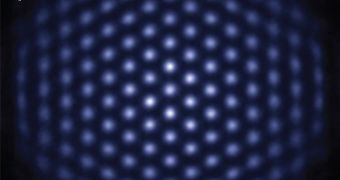A scientific instrument that can handle materials science-related problems like no conventional computer can has just been developed by National Institute of Standards and Technology (NIST) physicists, in the United States.
According to the research team, the new quantum simulator is capable of modeling up to 10 times the number of quantum bits (qubits) that previous-generation devices can. This will contribute to the advancement of studies related to producing quantum computer and other next-generation technologies.
Details of the achievement appear in a paper entitled “Engineered 2D Ising interactions on a trapped-ion quantum simulator with hundreds of spins,” which is published in the April 26 online issue of the top scientific journal Nature.
NIST physicists say that many of the problems still unresolved in the field of physics today manage to retain their secrets because of the extremely vast complexity of the quantum mechanics underlying them. The new simulator will soon start to resolve this complexity in small increments.
This device will be especially relevant to problems in the field of low-temperature physics, where quantum effects and interactions are very complex. Due to the fact that it can simulate hundreds of qubit interactions, it will far exceed the power of any existing supercomputer.
The most advanced computers today cannot even simulate quantum systems featuring a small number of particles. Researchers say that these machines quickly reach their limits when asked to analyze how 30 particles interact in such a system.
“The NIST simulator consists of a tiny, single-plane crystal of hundreds of beryllium ions, less than 1 millimeter in diameter, hovering inside a device called a Penning trap,” a NIST press release explains.
“The outermost electron of each ion acts as a tiny quantum magnet and is used as a qubit—the quantum equivalent of a '1' or a '0' in a conventional computer,” the statement goes on to say.
According to the research team, the NIST simulator can engineer both of the most important properties in quantum mechanics – superposition and entanglement. The former holds that particles can exist in two states at the same time, while the latter indicates that multiple particles can be linked with each other directly.
Investigators from the Georgetown University, the North Carolina State University, South Africa and Australia were also a part of the Defense Advanced Research Projects Agency-funded (DARPA) study.

 14 DAY TRIAL //
14 DAY TRIAL //